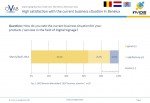invidis: You have taken part in the first DBCI survey in Benelux, how do you rate the results and their relevance for the Digital Signage industry?
Van Hout: I liked the results very much. They represent the vision I have on the Benelux market and they are very relevant to the Digital Signage Industry. Issuing this survey also for the Benelux market is a great initiative. I encourage everyone to take part in the survey as this gives a great insight into the general sentiment about the digital Signage market.
invidis: The analysis of the DBCI shows a very strong positive trend, what is your view on the current business situation and how are your expectations for Digital Signage in Benelux?
Van Hout: The digital Signage market is growing. Since hardware costs are dropping in general 50% every 3 years , larger networks are able to be deployed running a healthy business case. Engaging with customers in an omni-channel way is hot and marketers understand that there are multiple channels to use for an immersive customer experience. It is however very important to position screens in concepts where they really add value. Years ago screens were installed as digital posters and often from a “me too” perspective but these days more and more concepts are deployed with real customer engaging functionality. It is all about grabbing the attention of your target audience when they are open for business or when they need to make decisions. Not only on buying products but also to find your way around or know the latest information about the company you are working in. The mobile screens have a strong position but still the digital signage screens add a lot of value in call to action.

invidis: In the German speaking market the year 2013 started very positive, but lost some dynamic towards the end. How was the year 2013 for the Benelux market?
Van Hout: In Benelux the end of year was very strong. This is a tendency we have seen over the last few years. Even the growth at the end of last year didn’t stop at the beginning of 2014. We saw a strong growth in Q1 2014 compared to Q1 2013.
invidis: Benelux is always referred to as one market. However the three countries differ in many ways. What are the most striking differences concerning the Digital Signage industry?
Van Hout: I disagree with the idea that Benelux is one market. In the Netherlands we often think that the Belgium market is the same as they partly speak Dutch. Looking at digital signage in Belgium this market is growing very strong at the moment. Their growth is stronger than in the Netherlands in terms of % growth rate. Where The Netherlands was far ahead years ago by deploying screens, often initiated from the advertisement market in larger projects, we see a different use in the Belgium market. In the Belgium market customers are more looking at the added “soft” value of the Digital Signage system. “How does this help my customer”, “How does this strengthen my brand?“ The Belgium market skipped “the boom” in deploying screens just for advertisement. We also see that the average network size of Belgium deployments are bigger than in the Netherlands. This may be due to the fact that big retailers are investing in Digital Signage now, but with ROI as a focus, rather than shared ad revenue networks. Luxembourg is a very small market. Besides that we see that a lot of companies from the surrounding countries are delivering solutions into Benelux.

invidis: Which main challenges will the Digital Signage industry in Benelux face in 2014?
Van Hout: The needs are changing. Not a simple moving poster but more engaging solutions. Screens will be interacting more and more with external systems to have a targeted message. In the woods of triggers you get as a person it is important to stand out. To be able to do so platforms can’t have closed architectures, rather being able to extend beyond just the signage platform via API’s for example.
Networks are growing and management of these large networks can become an issue without the right solution. Managing a 10 player network is much easier than a 2000 player retail network, driving a lot of locations, showing multiple languages and having a difference in product portfolio.
Besides the functionality of the platforms there is a big challenge in content creation. As the amount of screens and channels are growing, a lot of content needs to be produced. Sometimes even different scenarios for the same location when hooking up predictive analytics systems to engage better with your audience. This also needs new thinking from marketing agencies.
I also see a challenge in the way we are going to measure effectiveness. On the web there are very established methodologies for tracking your audience because they all go to a central managed and traceable system. During ISE we had a crowded booth with people interested in the solutions we showed. Nearly all solutions where showing integration with for instance Social media, i-Beacons, Camera etc. These kind of solutions are appealing to the public and are going to change the way we use digital screens today. So where is the cookie in the Digital Signage solutions? I think we have it already in our hand!
Download the full DBCI March-April 2014 survey for Benelux here.

